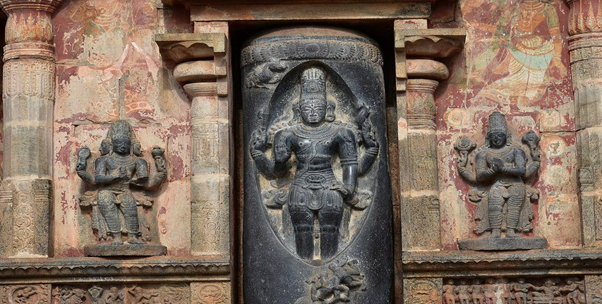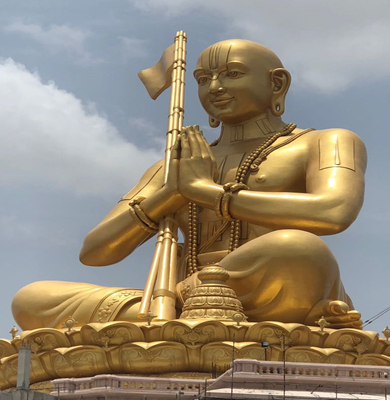

Before the emergence of big empires and kingdoms, people usually lived in small communities and prayed to their gods and goddesses. Buddhism and Jainism became one of the most dominating religions in the fifth century afterwards.
The idea of a Supreme God became prominent after the eighth century, with the beginning of the bhakti movement. The bhakti movement brought the revival of Hinduism. It spread the idea of a supreme god and one can achieve true liberation only by praying and devoting himself to god. It challenged the beliefs of Buddhism and Jainism. Buddhism and Jainism claimed that one can break the cycle of rebirth through personal efforts and it has nothing to do with the caste. But on the other hand, the new bhakti idea emphasised the need for complete devotion to the deity or supreme god for achieving Moksha.
The Bhakti movement started in south India and became popular in Bihar, Bengal and Assam. The core idea of the Bhakti movement was complete devotion to God and it was the only way to break the cycle of life and death. People were influenced by the idea that devotion to God could free them from the bondage o rebirth. Such ideas were seen in Bhagwatgeeta.
Gods like Shiva, Durga and Vishnu became most worshipped in that time, and new ritual practices for gods also emerged. Magnificent temples were built to show the supremacy of Shiva and Vishnu. Many local gods and goddesses were brought under Hinduism and were identified as the form of supreme gods. The religious practices became more and more complex and it also increased the arrogance of Brahmans. The bhakti path opposed these rituals and practices and focused on the love between worshippers and gods.
The Bhakti saints worshipped Shiva and Vishnu but they did not follow the old practices and rituals. It started in south India and was divided into two sects, one that worshipped Shiva were Nayanaras. The sect devoted to Vishnu was Alvaras. They were Tamils and people from every caste were members of sects. They preached love toward gods. Later, many Puranas came into existence which claimed that people can break the cycle of rebirth by completely devoting themselves to god, regardless of their caste.
Alvaras and Nyanaras during the bhakti movement moved from place to place, composing songs and praying to the deities. Whichever village they visited, they composed poems for enshrined deities of the village. By doing these they won over many Buddhists, Jainas and Even brought many tribes into the Hindu fold.
During the twelfth century, many Pandya and Chola kings built many elaborate temples throughout south India, around the shrines visited by famous bhakti saints, They wanted to create a link between Bhakti Traditions and Temples.
It was the time when Poems and songs were composed for praising deities. The religious pieces of literature of Alvaras and Naynaras were written in this period and which is still available as the history of the bhakti movement.
There were approximately 63 Nayanaras, they belonged to different casts, such as peasants, potters, soldiers, Untouchables and brahmans. There were no caste restrictions among them. Tiruvacakam and Tevaram are the two sets of compiled songs by Naynaras.
Alvaras were 12 in number and they were also equally diversified in caste as the Nayanaras. Divya Prabandham is their compilation of songs.

Temples Built by Nayanaras, Dedicated to the God Shiva
Richard Mortel from Riyadh, Saudi Arabia, CC BY 2.0
The Bhakti movement was not only associated with religious practices and rituals, but it also gave rise to new ideas which became a major part of Indian philosophy. These ideas also helped the bhakti movement to popularise. In north India, the bhakti movement was accompanied by powerful literary works and ideas.
The most important ideas were given by Shankara, he reformulated the Hindu philosophy. He was born in the 9th century in Kerala. He gave the concept of Advaitavada which means the doctrine of non-dualism. It claims that god and the soul are not two different entities, but one. people can’t realise this due to arrogance which is, Maya. He proposed that Vedas are true knowledge and gave the philosophy of Vedanta. According to Shankara, renunciation of illusion and following the path of true knowledge will lead to salvation.
Another major idea in philosophy was given by Ramanujam, he was influenced by Alvaras and according to him, salvation can only be achieved by intense devotion to Vishnu. He gave the doctrine of Vishishtadvaita meaning qualified non-dualism. It claims that even if the soul is united with the supreme god, it remains distinct. His ideas were credited for the revival of the bhakti movement in North India.

Statue Equality. It Shows Details of Ramanujacharya Having a Tulasi Necklace, Namam, etc
Nampar10, CC BY-SA 4.0
The Bhakti Movement started in the eighth century in south India. It was a counter Idea to the increasing Brhamanical arrogance in the religious sphere. Complex rituals and practices had discarded Hinduism and people from lower caste had left Hinduism and adopted Buddhism and Jainism. The bhakti tradition was an idea for reform in Hinduism and its revival. It spread the idea of a supreme god and one can achieve complete liberation by devoting himself completely to the god, regardless of his caste.
Q1. What was the reason for people adopting Buddhism and Jainism?
Ans. The increasing complexity of rituals and the growing arrogance of Brahmans led the dissatisfaction among lower caste people. This growing dissatisfaction led them to the adoption of other religions where they were treated as equals.
Q2. How Hagiographies are useful for modem days?
Ans. Hagiographies are the religious biographies of Bhakti saints, and today these are used as sources for writing histories of the Bhakti movement.
Q3. What was the core idea of the Bhakti tradition?
Ans. Bhakti tradition emphasized the idea of the supreme god, and any individual can attain liberation by fully devoting himself to the god.
Q4. According to Shankara, how can one achieve salvation?
Ans. Shankara claimed that to achieve salvation one had to discard the apparent world, which is an illusion and follow the path of true knowledge and understand the true nature of the world. One has to understand the singularity of soul and god to attain salvation.
Q5. What was the role of Pandyas and Chola kings in bhakti tradition?
Ans. Chola and Pandayas kings built many temples around the shrines visited by bhakti saints during the tenth and twelfth centuries. These kings played an important role in linking the Bhakti tradition with temple worshipping.